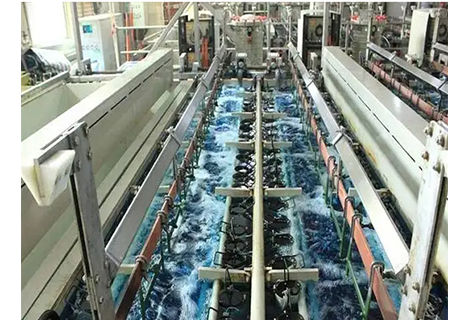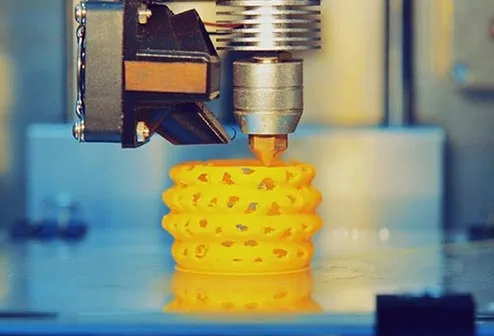A shaft is basically a rotating part of any machine, having a circular cross-section, which is used to transmit power from one part to another or from a power generating machine to a power absorbing machine. To transmit power, one end of the shaft is connected to the power source and the other end is connected to the machine. Shafts can be solid or hollow as per requirement, hollow shafts help in reducing weight and provide advantages.
Shafts are one of the very important components used in machines. They are used to support rotating parts such as pulleys and gears, which are supported by bearings located in rigid machine housings, and gears and pulleys located on the shaft help to transmit motion.
Many other rotating elements are mounted on shafts by means of keys. They are subjected to bending moments and torques due to the reaction forces of the members supported by the shaft and the torque generated by the power transmission.
Shafts always have a circular cross-section and can be hollow or solid. Shafts can be crank, linear, articulated or flexible, but linear shafts are usually used for power transmission.
Shafts are usually designed as steeply stepped cylindrical rods, so they have different diameters throughout their length, although shafts with constant diameters are easy to produce.
The amount of stress in a stepped shaft varies with its length. Shafts with a uniform diameter are not suitable for disassembly, assembly, and maintenance, and these shafts create complications in fastening the parts mounted on them, especially bearings.
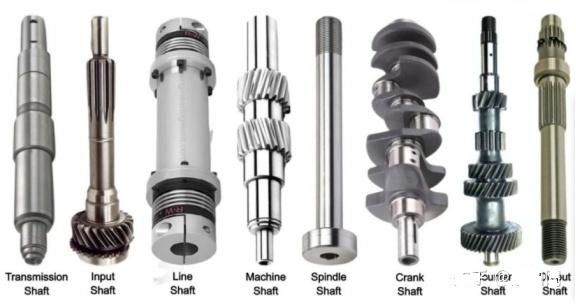
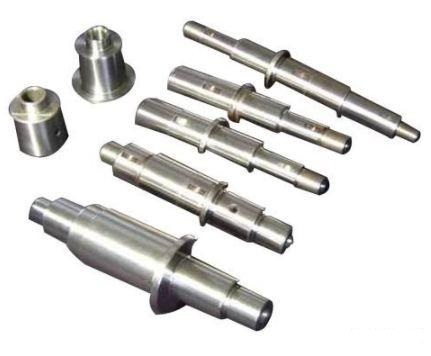
Drive shafts are stepped shafts used to transfer power from one source to another in machines that absorb power. They are mounted on stepped sections of shaft gears, hubs or pulleys for transmitting motion. Such as overhead shafts, line shafts, sub shafts and all factory shafts.
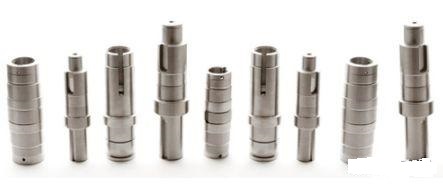
Mechanical shafts are located inside the component and are an integral part of the machine, e.g. the crankshaft in an automobile engine is a machine shaft.
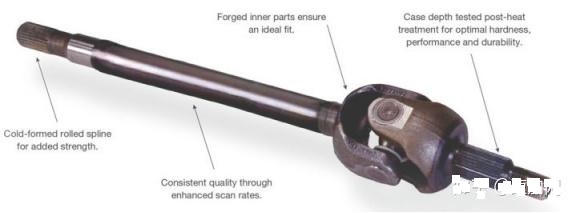
axle shafts shafts support rotating elements, e.g. wheels, and can be mounted in housings with bearings, but the shafts are non-rotating elements and are mainly used in vehicles, e.g. axles in automobiles.
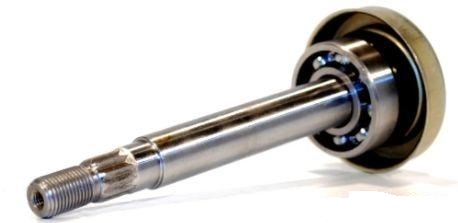
A spindle is the rotating part of a machine that holds a tool or workspace and is used as the short axis of a machine, e.g. the spindle in a lathe.
Shafts are usually made of mild steel. If high strength is required alloy steels are used, such as nickel-chromium, nickel, and chrome-vanadium steels. They are formed by hot rolling and cold drawing and grinding. The materials normally used for conventional shafts are carbon steels of grades 50C12, 50C4, 45C8, 40C8.
The material used for shafts should have the following properties:
The material should have high strength .
The material should have high wear resistance.
The material shall have heat treatment properties.
The material shall have good mechanical properties.
The material must have a low notch sensitivity factor.
Mechanical shafts up to 25 mm in 0.5 mm steps.
Standard dimensions for transmission shafts - step length:
25 mm to 60 mm - 5 mm step .
60 mm to 100 mm - 10 mm steps.
110 mm to 140 mm - 15 mm steps .
140 mm to 500 mm - 20 mm steps.
For machine shafts, standard sizes are up to 25 mm with 5 mm step lengths. For shafts, standard lengths are 5m, 6m and 7m, but generally 1m to 2m is taken.
The stresses induced in the shaft are:
Shear stresses due to torque transmission (torque due to torsional loading) .
Bending stresses due to forces acting on mechanical elements (e.g. pulleys and gears) and the self-weight of the shaft, which are compressive or tensile in nature.
Combined stresses due to bending and torsional loads.
The maximum allowable shear stress for design stress is:
56000KN/m2 for the shaft, with allowance for keyway.
Shaft 42000KN/m2 without keyway allowance.
The maximum allowable bending stress is:
112000 KN/m2 for shaft with keyway allowance.
84000 KN/m2 for shafts without keyway allowance.
The shaft is manufactured by hot rolling. The strength of the shafts is higher in cold rolling as compared to hot rolling, but cold rolling leads to high residual stresses which cause deformation of the shafts during machining. The forging process is used to manufacture shafts of larger diameters.
After rolling is completed, the shafts are end-machined, with one end of the shaft mounted on a check and the other end of the shaft supported by a lathe turret. For finishing the shaft, the tool is fixed in the tool holder and when the power is turned on, the chuck starts rotating the shaft.
Micrometer is used to check the concentricity of the shaft before machining and customize CNC turning, facing, grooving, taper turning and many other operations according to the usage. Applications such as high volume and CNC are best suited for final machining processes. Machining can also be done with CNC double-ended machines where the shaft is clamped between the tool rotation and the fixture.
To achieve concentricity and roundness, the rotating tools should be opposite each other at the centerline. Drive shafts and motors are usually manufactured using this process.
We know that shafts are used for power transmission, so the equation used to calculate power transmission is: P = 2πnT/ 60 . Where P is the power transmitted (W); n is the revolutions per minute (RPM); and T is the torque in Nm.
Speed of shafts used for various applications:
Mechanical : 100~200
Woodworking machinery: 250~700
Textile: 300~800
Light machine shop: 150~300
Sub-shafts: 200 to 600
Shafts can be designed through two different processes depending on the loads to be considered:
01. Strength-based shaft design Transmission shafts are usually susceptible to bending moments, torsional moments, axial tensile forces and their combinations. Typically, bearings are subjected to combined loads of torsional and bending stresses.
Bearings are subject to tensile stresses: tensile stress = P/A. where A = (π/4) x D2 and D is the diameter of the shaft in mm.
Bearing subjected to bending moment: Bending stress = (MbxY)/ I. Where, Mb = bending moment; Y = D/2, where D is the diameter; I = moment of inertia = (πxD4)/ 64
Bearing subjected to torsional moment: Torsional stress = Mt x R/J. where, Mt = torsional moment; R = D/ 2, where D is the diameter; J = polar moment of inertia = (πxD4)/ 32
02. Shaft design based on rigidity
A drive shaft is said to be rigid on the basis of torsional stiffness if the shaft will not twist too much.
{Mt/J} = {(G x ө)/ L}. Where, Mt = torque in N in mm; J = polar moment of inertia = (πxD4)/32; D = diameter of the shaft in mm; ө = angle of torsion; G = modulus of stiffness N/mm2
Advantages of shafts:
They are less likely to jam .
They require less maintenance than chain systems.
They have high torsional strength.
They have high values of polar moments of inertia.
They are very robust and unlikely to fail.
Hollow shafts have a hollow internal shape, so they require less material.
Hollow shafts are lighter than solid shafts for the same torque transmission value.
They have a high radius of rotation.
Disadvantages of shafts:
They have power losses due to loose coupling.
They vibrate during rotation.
They generate constant noise.
Higher manufacturing and maintenance costs.
Manufacturing is difficult.
It is not easy to change the speed of the shaft.
Downtime is long due to mechanical problems.
Oil dripping from elevated shafts.
The use of flexible couplings (e.g. leaf spring couplings) results in a loss of speed between shafts.
If the shaft fails, it takes a lot of time to repair.
In today's article, we take an in-depth look at the different types of shafts, materials, stresses, manufacturing and design, and their importance in machinery and industry. Shafts play a key role in connecting and transmitting power as the rotating part of a machine, so they must be designed and manufactured with careful consideration and engineering practices.
As a precision manufacturing company, Richconn specializes in providing high quality precision CNC milling services and custom sheet metal services. Our team of professionals has the experience to meet your specific needs and ensure that the shafts provided meet the highest standards. If you're looking for a reliable partner for your fabrication needs, consider Richconn and we'll be happy to provide you with exceptional service.
If you have any questions about shafts or other fabrication services, or are interested in our services, please feel free to contact us. We look forward to assisting you and working together to drive your project to success. Thank you for reading this article and we wish you success in your future manufacturing endeavors!
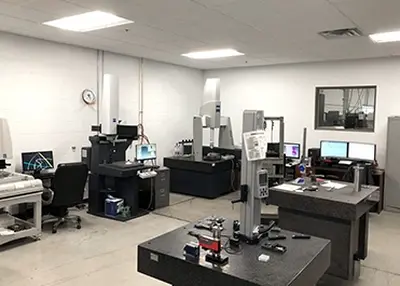 CNC Machine vs 3D Printer: A Comprehensive ComparisonNovember 6, 2023As the proud owner of Richconn, a CNC machining service provider, I understand the importance of choosing the right manufacturing technology for your production needs. The decision between CNC machines and 3D printers can be a daunting one, and that's why I'm here to provide you with a comprehensive comparison to help you make an informed choice.view
CNC Machine vs 3D Printer: A Comprehensive ComparisonNovember 6, 2023As the proud owner of Richconn, a CNC machining service provider, I understand the importance of choosing the right manufacturing technology for your production needs. The decision between CNC machines and 3D printers can be a daunting one, and that's why I'm here to provide you with a comprehensive comparison to help you make an informed choice.view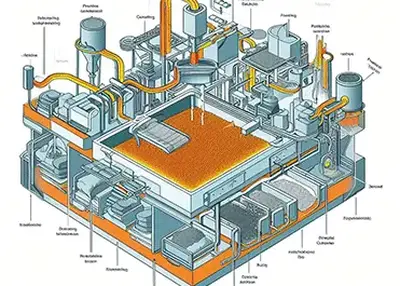 What is the Powder Bed Fusion Process?November 28, 2023Powder bed fusion (PBF) is a type of additive manufacturing, or 3D printing, that uses a heat source, such as a laser or an electron beam, to melt and fuse material powder together to create solid parts.view
What is the Powder Bed Fusion Process?November 28, 2023Powder bed fusion (PBF) is a type of additive manufacturing, or 3D printing, that uses a heat source, such as a laser or an electron beam, to melt and fuse material powder together to create solid parts.view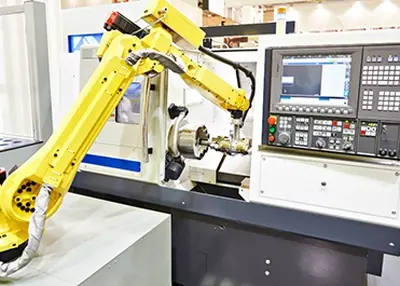 CNC Machining and AI: How Artificial Intelligence is Impacting the FieldOctober 25, 2023Artificial Intelligence is having a profound impact on CNC machining services, transforming operations and delivering many benefits. Here are some of the key areas where AI is playing a major role:view
CNC Machining and AI: How Artificial Intelligence is Impacting the FieldOctober 25, 2023Artificial Intelligence is having a profound impact on CNC machining services, transforming operations and delivering many benefits. Here are some of the key areas where AI is playing a major role:view The Application of CNC Machining in Mechanical Equipment - CNC PartsMay 13, 2024Discover the wide range of applications and future trends of CNC machined parts in mechanical equipment. From high precision to increased efficiency, this technology is pushing forward the industry. Explore the possibilities now!view
The Application of CNC Machining in Mechanical Equipment - CNC PartsMay 13, 2024Discover the wide range of applications and future trends of CNC machined parts in mechanical equipment. From high precision to increased efficiency, this technology is pushing forward the industry. Explore the possibilities now!view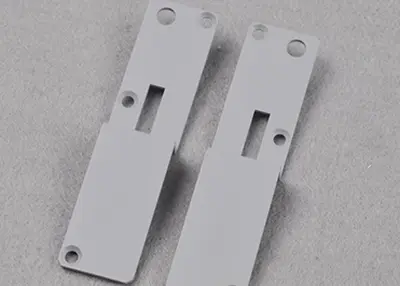 A Strong Piece - Anodized AluminumOctober 12, 2023Did you know that the oxide layer created when anodizing aluminum is almost as hard as a diamond, making it exceptionally resistant to abrasion? It also provides excellent corrosion resistance.view
A Strong Piece - Anodized AluminumOctober 12, 2023Did you know that the oxide layer created when anodizing aluminum is almost as hard as a diamond, making it exceptionally resistant to abrasion? It also provides excellent corrosion resistance.view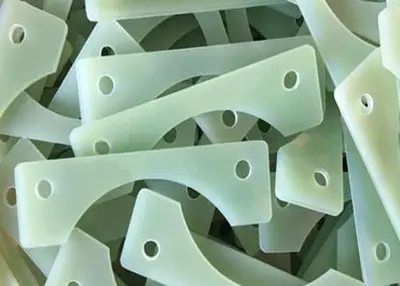 Waterborne Aluminum Powder Coating on(Nylon+Fiberglass )Composite Materials: The Innovative Path to the FutureAugust 8, 2023Waterborne aluminum powder coating on nylon+fiberglass composite materials is an ingenious technology that combines nylon and fiberglass to give a unique metallic appearance. This innovative coating t...view
Waterborne Aluminum Powder Coating on(Nylon+Fiberglass )Composite Materials: The Innovative Path to the FutureAugust 8, 2023Waterborne aluminum powder coating on nylon+fiberglass composite materials is an ingenious technology that combines nylon and fiberglass to give a unique metallic appearance. This innovative coating t...view
 EN
EN
 ru
ru 
